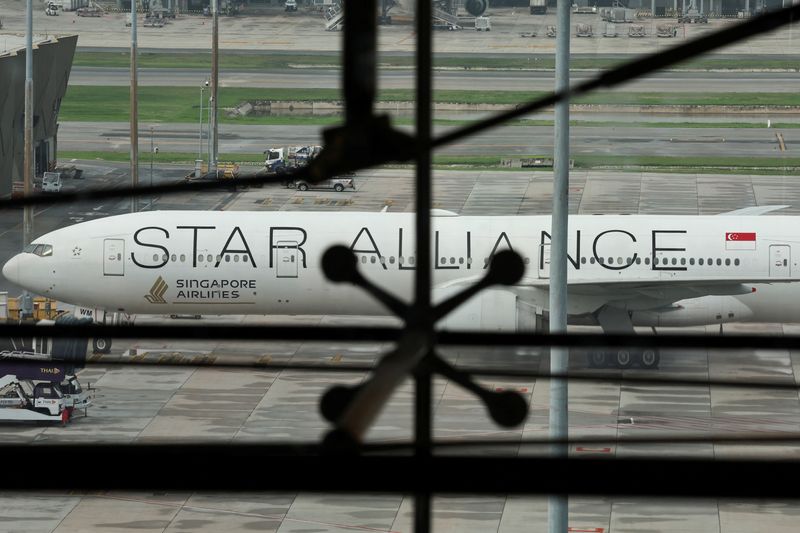By Lisa Barrington
SEOUL (Reuters) -Singapore Airlines has changed its in-flight seatbelt rules and altered at least one flight route after a turbulence incident this week killed one person and left dozens critically injured, according to the airline and flight data.
The airline is adopting a more cautious approach to turbulence, including not serving hot drinks or meals when the seatbelt sign is on, it said in a statement to Singapore broadcaster Channel News Asia.
"SIA will continue to review our processes, as the safety of our passengers and crew is of utmost importance," it said.
The airline did not respond to a Reuters request for comment.
The SQ321 London-Singapore flight on a Boeing (NYSE:BA) 777-300ER plane carrying 211 passengers and 18 crew diverted to Bangkok for an emergency landing on Tuesday after the plane was buffeted by turbulence that flung passengers and crew around the cabin, slamming some into the ceiling.
Singapore investigators have started examining data obtained from the cockpit voice recorder and flight data recorder, Singapore Transport Minister Chee Hong Tat said on Friday.
The daily London to Singapore route SQ321 has completed two flights since the incident and has not flown over the part of Myanmar where the sudden turbulence occurred about three hours before scheduled landing. The flight time is about the same, tracking data show.
They flew instead over the Bay of Bengal and Andaman Sea, route data from flight tracker FlightRadar 24 showed.
Singapore Airlines (OTC:SINGY) has said the plane on Tuesday encountered sudden extreme turbulence. A 73-year-old British passenger died of a suspected heart attack.
Photographs from inside the plane showed gashes in the overhead cabin panels, oxygen masks and panels hanging from the ceiling and luggage strewn around. A passenger said some people's heads had slammed into the lights above the seats and broken the panels.
As of late Thursday, 48 passengers and two crew members were hospitalised in Bangkok; 19 others were still in Bangkok, the airline said.
Twenty of the 48 remained in intensive care, an official at Bangkok's Samitivej Srinakarin Hospital said on Thursday, adding that the injured had a mix of spinal cord, brain and skull injuries.
Singapore Airlines, widely recognised as one of the world's leading carriers and seen as a benchmark for the industry, has not had any major incidents in recent years.
TURBULENCE
A spate of turbulence reports has triggered a debate over whether climate change may be causing it. A report from the University of Reading last year suggested turbulence could worsen with climate change.
Professor Paul Williams, one of the authors, has said more research is needed to understand the impact of climate change on air turbulence.
Technological advances have helped limit the number of turbulence-related fatalities, which have significantly decreased in the past 20 years.
Airlineratings.com Editor-in-Chief Geoffrey Thomas said some airlines may change their policy on wearing seatbelts as a result of the incident.
Airlines are required by law to switch on the seatbelt sign during takeoff and landing, but carriers have their own procedures to deal with midair turbulence.
"I think this incident will prompt airlines, whether it's an official mandate or not. But airlines saying ‘we recommend you keep your seatbelt fastened while seated’, should be saying it is mandatory to keep your seatbelt done up,” Thomas said.
Norwegian Air said it has not discussed whether to make any changes to its flights, a spokesperson said.

The type of turbulence the Singapore Airlines plane experienced is extremely rare on its main routes - from Nordic countries to European destinations.
The airspace over Europe is heavily trafficked and the wind and weather data is often updated and shared, they said.